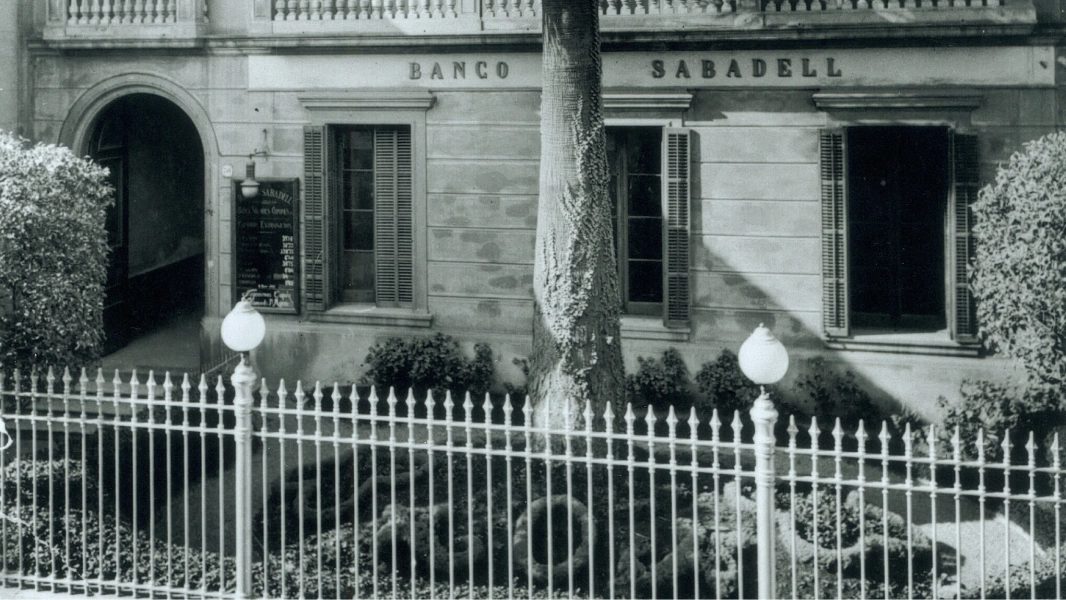
Financial Services
We serve more than 11.5 million customers in over 14 countries
Read more
We are the result of our history. The history of Banco Sabadell is the story of the launch of a small local bank at the end of the 19th century, which, over time, has grown into a multinational banking group with a set of corporate values that have defined its very way of being and carrying out its banking work.


In 1881, a group of businessmen from the city of Sabadell founded Banco de Sabadell with a capital of 10 million pesetas. The early years were characterised by the bank’s active role in the wool and coal mining trade, which it abandoned in the early 20th century to focus exclusively on financial services.
The 1920s and 1930s were characterised by the economic crisis, political instability, and social conflicts, difficulties that the bank overcame thanks to the good governance that emerged from the crisis of confidence that the bank had experienced in 1926.

In the 1940s, the bank focused its activity on stabilising its situation and restoring normality after the Spanish Civil War. Years later, it had gained a high degree of trust. The country’s economic recovery had allowed it to grow in terms of operations and share capital until, in 1965, it opened its first office situated outside Sabadell, in Sant Cugat del Vallès.
From then on, the bank's branches spread to nearby towns as far as Barcelona, becoming firmly established and contributing to the economic and business development of the region. Shortly after that, it opened its first branch in Madrid, and at the end of the 1970s its first foreign branch, in London.

In 1996, the bank’s first non-organic deal was formalised with the purchase of the NatWest España group. The new millennium began with the purchase of Banco Herrero and its flotation, which took place on 18 April 2001.
In 2003, the purchase of Banco Atlántico was signed, which meant an increase in size that made Banco Sabadell one of the leading institutions in the Spanish market. In 2004, the bank’s shares were included in the IBEX 35 index. In 2006, Banco Urquijo was acquired, and in 2007, so was TransAtlantic Bank of Miami in the United States.

Banco Sabadell positioned itself as a one of the buying entities in the process of bank concentration triggered by the great financial crisis, which erupted in 2008 following the collapse of Lehman Brothers. In Spain, it acquired Banco Guipuzcoano (2010), Banco CAM (2011), the branch network in Catalonia and Aragon of the former Caixa Penedès (2012), Banco Gallego, and the Spanish business of Lloyds (2013).
In addition to this, the bank began an ambitious process of internationalisation, which materialised with the acquisition of the British bank TSB in 2015 and the creation of a bank in Mexico in 2016. The bank became one of the largest institutions in the Spanish financial system during these years, tripling its size, geographically diversifying its business, and increasing its customer base sixfold, all while safeguarding its solvency and liquidity. On 31 December 2021, Banco Sabadell celebrated its 140th anniversary, looking to the future with the same drive, enthusiasm, and ambition that it had possessed on 31 December 1881.
The Archivo Histórico Banco Sabadell (Banco Sabadell History Archive – AHBS) was founded in 2005 to preserve and disseminate the bank's historical heritage since 1881. Managed by the Banco Sabadell Foundation, it has the necessary resources to safeguard the documentary collection of the group and of the entities incorporated over time. Specialising in banking and heritage documentation, it is of great interest to those studying the economic history of Catalonia and Spain in the 19th and 20th centuries.
The AHBS has a constantly growing database of 57,000 records and is one of the few historical banking archives in Spain open to the public. It has participated in the publication of the "Guide to historical archives of banking in Spain", the result of the Project for the Recovery of Historical Archives of banking in Spain, promoted by the Bank of Spain.

We serve more than 11.5 million customers in over 14 countries
Read more

We work to support and accelerate economic and social transformations toward a sustainable future
Read more

We are the fourth largest private banking group in Spain, founded in 1881 and on the IBEX 35.
Read more